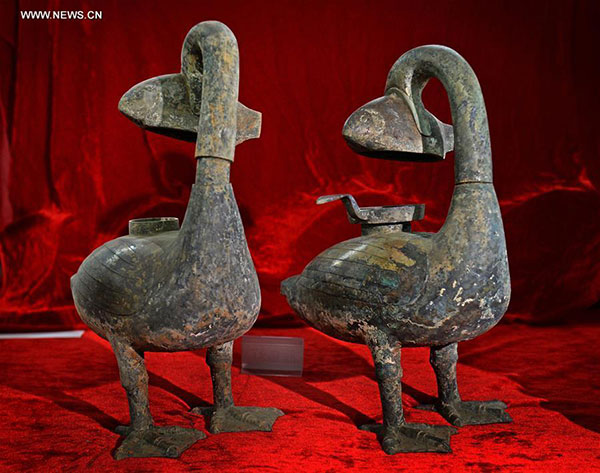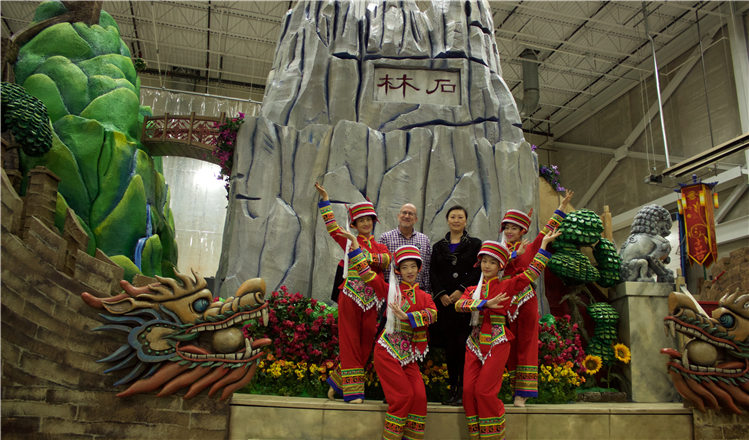Chinese archaeologists unearth ancient smoke-absorbing lamps
Updated: 2015-11-13 10:39
(Xinhua)
|
||||||||
 |
|
Photo taken on Nov 6, 2015 shows bronze lamps unearthed from the excavation site of royal tombs of Marquis of Haihun State during the West Han Dynasty (206 BC-25 AD) in Nanchang, capital of East China's Jiangxi province. [Photo/Xinhua] |
Millennia before China's smog made world headlines, Chinese lamp makers were coming up with designs to reduce air pollution, a new discovery has showed.
Chinese archaeologists excavating a noted Western Han Dynasty (206 BC - 24 AD) cemetery in East China's Jiangxi Province have unearthed two 2,000-year-old bronze lamps that can "swallow" smoke.
The lamps are both the shape of a goose catching a fish in its mouth. The light is attached to the fish. Smoke emitted during the burning of wax can enter the bird's body via an intake on the fish, travel through its neck and be dissolved by water stored in its hollow belly, Xin Lixiang, who leads the excavation team, told Xinhua on Thursday.
"It is both an artwork and an example of ancient innovation," Xin said, adding that the lamps can be dismantled for cleaning and have swinging lamp shades to adjust brightness.
The Han Dynasty was the heyday for Chinese bronze lamps, but such smoke-absorbing designs were probably affordable only by high nobles.
The two lamps were found in September in the tomb of "Haihunhou" (Marquis of Haihun). Located near provincial capital Nanchang, the Haihunhou cemetery is the most complete Western Han Dynasty cemetery ever discovered in China. It covers roughly 40,000 square meters and contains eight tombs and a burial site for horses used to pull chariots.
Its main tomb is thought to belong to Liu He, grandson of Emperor Wu, whose reign ushered in one of the most prosperous periods in China's history. Liu was given the title "Haihunhou" after he was deposed as emperor after only 27 days. Haihun is the ancient name of a very small kingdom in the north of Jiangxi.
The site's excavation started in 2011 and is ongoing. Artifacts unearthed so far include nearly 3,000 wooden tablets and bamboo slips and a large number of bronze, gold and jade items.

 Veterans Day marked across the United States
Veterans Day marked across the United States
 Antalya: Beautiful place where G20 will be held
Antalya: Beautiful place where G20 will be held
 Interesting trends revealed by Singles Day
Interesting trends revealed by Singles Day
 10 delicious soups you can't miss in cold winter days
10 delicious soups you can't miss in cold winter days
 Xi-Ma meeting lauded in US
Xi-Ma meeting lauded in US
 Kunming's parade float: set in stone
Kunming's parade float: set in stone
 All-nighters pulled for Single's Day shopping festival
All-nighters pulled for Single's Day shopping festival
 Victoria's Secret Fashion Show
Victoria's Secret Fashion Show
Most Viewed
Editor's Picks

|

|

|

|

|

|
Today's Top News
Obama, Netanyahu at White House seek to mend US-Israel ties
China, not Canada, is top US trade partner
Tu first Chinese to win Nobel Prize in Medicine
Huntsman says Sino-US relationship needs common goals
Xi pledges $2 billion to help developing countries
Young people from US look forward to Xi's state visit: Survey
US to accept more refugees than planned
Li calls on State-owned firms to tap more global markets
US Weekly

|

|






